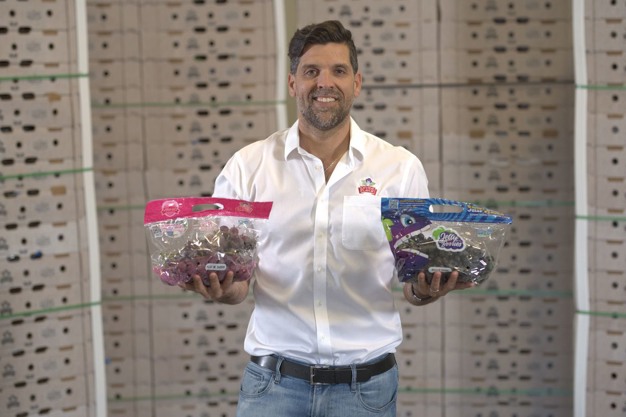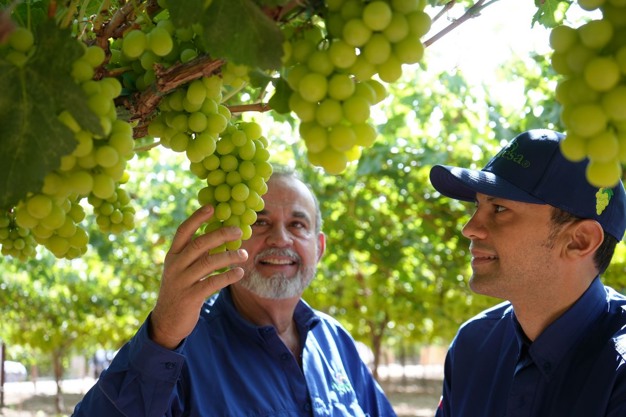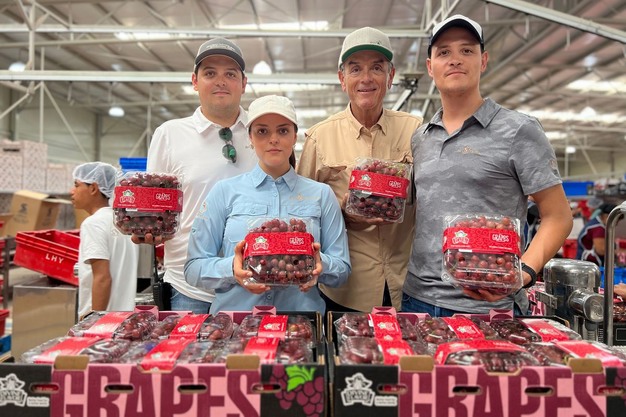The Sonora grape season has been past its peak for about 15 days now and volumes of regular green and red grapes have started going downhill. Grapes will get harvested and shipped for another two weeks, but shipments are rapidly decreasing from the peak of 600,000 boxes per day. "This is bittersweet as the quality of the regular grapes from Sonora is always at its best towards the end of the season," says Carlos Bon with Divine Flavor. When early varieties like Flame and Prime hit the market, the brix level is often low and this year, the fruit was small in size. "Now, in the later part of the season, Sweet Celebration™ and Sweet Globe™ are showing fantastic sizing and great eating quality," said Bon.
In addition to regular varieties, Sonora also started harvesting specialty varieties about two weeks ago and these varieties will go for another month. Cotton Candy™, Gummyberries, and Jellyberries are the main specialty varieties for Divine Flavor. "Out of these three, Cotton Candy is our largest variety by far. We grow Cotton Candy on five different ranches and have increased volume by popular demand," Bon shared. This year happens to be a better year for Cotton Candy compared to last year. Gummyberries hold well in storage and therefore, allow for the season to be extended. Jellyberries on the other hand, aren't performing as well as Divine Flavor had hoped for, and the company is decreasing its acreage.

Carlos Bon, holding specialty grape varieties.
Pricing based on higher yields
All in all, the Sonora season was difficult at times. "The industry dealt with small sizing on the early varieties and movement slowed down as a result." Another challenge was the total production volume that came down significantly from its original estimate. Initially, the expectation was for Sonora to export 25 million boxes of table grapes to the U.S. "Pricing contracts with retailers were set at levels that were based on this number. Now that production volume will end up around 22 million boxes, we're short on yields, resulting in lower revenues. A 12 percent drop in production is quite significant as grape prices don't reflect this large of a yield drop and the season is just too short to react," Bon shared.

Divine Flavor growers, Eduardo Ortiz Ciscomani and Cesar Ortiz, are looking at Prime seedless grapes.
Not gapping on premium varieties
Prior to the start of the Sonora season, Divine Flavor shipped grapes out of Jalisco. "In this region, we only grow specialty varieties, creating expectations for quality and size." From high-quality grapes in Jalisco, the transition was made to Sonora where the season usually starts off with average quality fruit. "We need to step up our game in Sonora and grow the right varieties," said Bon. "In fact, it's a combination of genetics and grower skills. Partnering with a grower who understands the right varieties is key as it is really easy to screw up an excellent grape variety. At the same time, some growers do a great job in turning a mediocre variety into an excellent quality grape." The industry is gradually making progress by planting earlier and more premium table grape varieties with Ruby Rush being an example. "In the past, it was all about a smooth transition and not gapping while now it's about not gapping on premium varieties."

Emilo Vanegas, Nena Vanegas, Alberto Vanegas, and Marcelo Vanegas are growers for Divine Flavor, showing the Flame variety.
California
From Sonora, Divine Flavor's grape production will transition to California, a new program for the company. "We expect to start California in about 20 days and are excited to get going. It should be a very clean transition as Sonora's regular and specialty varieties will be pretty much done by the time California starts."
 For more information:
For more information:
Michael DuPuis
Divine Flavor
Tel: +1 (520) 281-8328
Email: mdupuis@divineflavor.com
www.divineflavor.com
